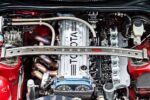Compression Ignition Diesel Engine
When it comes to heavy-duty vehicles and machinery, the compression ignition diesel engine stands out as a powerhouse. This engine type is renowned for its durability, fuel efficiency, and torque characteristics, making it the go-to choice for everything from trucks to construction equipment. Unlike gasoline engines, which rely on spark plugs to ignite the air-fuel mixture, diesel engines compress air to such high pressures that the fuel ignites spontaneously. This fundamental difference in operation leads to a range of advantages that make diesel engines the backbone of many industries.
How It Works
At the heart of the compression ignition diesel engine is its unique operating cycle. When the piston moves down, it draws in air, which is then compressed to a high temperature and pressure during the upward stroke. Once the piston reaches the top of its stroke, fuel is injected directly into the combustion chamber. The extreme conditions cause the fuel to ignite instantly, resulting in a powerful explosion that drives the piston back down. This cycle repeats, providing the engine with a continuous source of power.
Key Features
Several features set diesel engines apart from their gasoline counterparts. For starters, diesel fuel has a higher energy density, which translates to better fuel economy. Additionally, the engine’s design allows for higher compression ratios, leading to increased thermal efficiency. As a result, diesel engines can produce more torque at lower RPMs, making them ideal for heavy loads and challenging terrains.
In the world of automotive mechanics, understanding the intricacies of compression ignition diesel engines is crucial. Whether you’re maintaining a fleet of trucks or working on agricultural machinery, knowing how these engines operate can save you time and money.
Understanding the Compression Ignition Diesel Engine
Diving deeper into the world of compression ignition diesel engines reveals a complex yet fascinating mechanism that powers a significant portion of our transportation and industrial sectors. These engines are not just about brute force; they are marvels of engineering that combine efficiency, durability, and performance.
Components of a Diesel Engine
To grasp how these engines operate, it’s essential to understand their key components. Here’s a breakdown:
| Component | Function |
|---|---|
| Piston | Moves up and down to compress air and create power. |
| Cylinder | Houses the piston and facilitates combustion. |
| Fuel Injector | Injects fuel directly into the combustion chamber at high pressure. |
| Crankshaft | Converts linear motion of the piston into rotational motion. |
| Turbocharger | Increases engine efficiency by forcing more air into the combustion chamber. |
| Intercooler | Cools the compressed air before it enters the combustion chamber. |
How Compression Ignition Works
The operation of a compression ignition diesel engine can be broken down into several key phases:
Intake Phase
During this phase, the engine draws in air through the intake valve as the piston moves down. Unlike gasoline engines, no fuel is mixed in at this stage.
Compression Phase
As the piston moves back up, it compresses the air to extremely high pressures (often exceeding 20:1 compression ratios). This compression raises the air temperature significantly, preparing it for ignition.
Power Phase
Just before the piston reaches the top, fuel is injected into the high-pressure air. The heat from the compressed air ignites the fuel almost instantaneously, causing a rapid expansion that forces the piston back down.
Exhaust Phase
Finally, the exhaust valve opens, and the piston moves back up to expel the spent gases from the combustion process. This cycle repeats, providing continuous power.
Advantages of Diesel Engines
Compression ignition diesel engines come with a host of benefits that make them a preferred choice for many applications:
- Fuel Efficiency: Diesel engines are known for their superior fuel economy compared to gasoline engines. This is due to the higher energy content of diesel fuel and the engine’s efficient combustion process.
- Torque: Diesel engines produce a significant amount of torque at low RPMs, making them ideal for heavy-duty applications such as trucks and construction equipment.
- Durability: Built to withstand high pressure and temperatures, diesel engines tend to have a longer lifespan than gasoline engines when properly maintained.
- Lower CO2 Emissions: While diesel engines can produce more NOx and particulates, they generally emit less CO2 per unit of energy produced compared to gasoline engines.
Challenges and Considerations
Despite their advantages, compression ignition diesel engines are not without their challenges:
Emissions Regulations
Modern diesel engines must comply with stringent emissions regulations. This has led to the incorporation of advanced technologies like selective catalytic reduction (SCR) and diesel particulate filters (DPF) to reduce harmful emissions.
Cold Weather Performance
Diesel engines can struggle in cold weather due to the viscosity of diesel fuel. Special additives or winter-grade diesel fuel may be necessary to ensure proper operation during winter months.
Maintenance Requirements
While diesel engines are durable, they require regular maintenance to ensure longevity. This includes oil changes, fuel filter replacements, and regular checks on the fuel injection system.
Applications of Diesel Engines
Compression ignition diesel engines are found in a wide range of applications:
- Heavy-duty trucks and buses
- Construction and agricultural machinery
- Marine vessels
- Generators and stationary power applications
Understanding the intricacies of compression ignition diesel engines is essential for anyone working in the automotive or industrial fields. Their unique operating principles, combined with their benefits and challenges, make them a critical component of modern machinery and transportation.




0 Comments